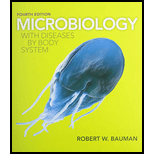
Microbiology with Diseases by Body System & Modified MasteringMicrobiology with Pearson eText -- ValuePack Access Card -- for Microbiology with Diseases by Body System Package
1st Edition
ISBN: 9780133857122
Author: Robert W. Bauman Ph.D.
Publisher: PEARSON
expand_more
expand_more
format_list_bulleted
Question
Chapter 17, Problem 6MC
Summary Introduction
Introduction:
Serology is a method which is used to analyze the blood for the presence of a specific antibody and antigens. There is wide-range of serological tests available to recognize the antigens or antibodies in the blood.
Expert Solution & Answer
Want to see the full answer?
Check out a sample textbook solution
Students have asked these similar questions
please draw in what the steps are given.
Thank you!
please draw in and fill out the empty slots from image below.
thank you!
There is a species of eagle, which lives in a tropical forest in Brazil. The alula pattern of its wings is determined by a single autosomal gene with four alleles that exhibit an unknown hierarchy of dominance. Genetic testing shows that individuals 1-1, 11-4, 11-7, III-1, and III-4 are each homozygous.
How many possible genotypes among checkered eagles in the population?
Chapter 17 Solutions
Microbiology with Diseases by Body System & Modified MasteringMicrobiology with Pearson eText -- ValuePack Access Card -- for Microbiology with Diseases by Body System Package
Ch. 17 - Prob. 1TMWCh. 17 - A diagnostician used an ELISA to show that a...Ch. 17 - To obtain immediate immunity against tetanus, a...Ch. 17 - Which of the following vaccine types is commonly...Ch. 17 - Prob. 3MCCh. 17 - When antigen and antibodies combine, maximal...Ch. 17 - An anti-antibody is used when _________. a. an...Ch. 17 - Prob. 6MCCh. 17 - Prob. 7MCCh. 17 - Prob. 8MC
Ch. 17 - Prob. 9MCCh. 17 - Prob. 10MCCh. 17 - Prob. 11MCCh. 17 - An antiserum is ________. a. an anti-antibody b....Ch. 17 - Prob. 13MCCh. 17 - Prob. 14MCCh. 17 - Prob. 15MCCh. 17 - Prob. 1MTFCh. 17 - Prob. 2MTFCh. 17 - Prob. 3MTFCh. 17 - Modified True/False 4. _________________ ELISA is...Ch. 17 - Prob. 5MTFCh. 17 - Match the characteristic in the first column with...Ch. 17 - Identify the chemicals represented by this artists...Ch. 17 - Prob. 2VICh. 17 - Compare and contrast the Chinese practice of...Ch. 17 - What are the advantages and disadvantages of...Ch. 17 - Compare the advantages and disadvantages of...Ch. 17 - How does precipitation differ from agglutination?Ch. 17 - Explain how a pregnancy test works at the...Ch. 17 - Compare and contrast herd immunity and contact...Ch. 17 - How does nephelometry differ from turbidimetry?Ch. 17 - Is it ethical to approve the use of a vaccine that...Ch. 17 - Which is worse: to use a diagnostic test for HIV...Ch. 17 - Discuss the importance of costs and technical...Ch. 17 - What bodily fluids, in addition to blood serum,...Ch. 17 - Why might a serological test give a false positive...Ch. 17 - Some researchers want to distinguish B cells from...Ch. 17 - Describe three ways by which genetic recombinant...Ch. 17 - How does a toxoid vaccine differ from an...Ch. 17 - Explain why many health organizations promote...Ch. 17 - Contrast a hemagglutination test with a viral...Ch. 17 - Prob. 11CTCh. 17 - Draw a picture showing, at both the molecular and...Ch. 17 - Prob. 1CM
Knowledge Booster
Similar questions
- students in a science class investiged the conditions under which corn seeds would germinate most successfully. BAsed on the results which of these factors appears most important for successful corn seed germination.arrow_forwardI want to write the given physician orders in the kardex formarrow_forwardAmino Acid Coclow TABle 3' Gly Phe Leu (G) (F) (L) 3- Val (V) Arg (R) Ser (S) Ala (A) Lys (K) CAG G Glu Asp (E) (D) Ser (S) CCCAGUCAGUCAGUCAG 0204 C U A G C Asn (N) G 4 A AGU C GU (5) AC C UGA A G5 C CUGACUGACUGACUGAC Thr (T) Met (M) lle £€ (1) U 4 G Tyr Σε (Y) U Cys (C) C A G Trp (W) 3' U C A Leu בוט His Pro (P) ££ (H) Gin (Q) Arg 흐름 (R) (L) Start Stop 8. Transcription and Translation Practice: (Video 10-1 and 10-2) A. Below is the sense strand of a DNA gene. Using the sense strand, create the antisense DNA strand and label the 5' and 3' ends. B. Use the antisense strand that you create in part A as a template to create the mRNA transcript of the gene and label the 5' and 3' ends. C. Translate the mRNA you produced in part B into the polypeptide sequence making sure to follow all the rules of translation. 5'-AGCATGACTAATAGTTGTTGAGCTGTC-3' (sense strand) 4arrow_forward
- What is the structure and function of Eukaryotic cells, including their organelles? How are Eukaryotic cells different than Prokaryotic cells, in terms of evolution which form of the cell might have came first? How do Eukaryotic cells become malignant (cancerous)?arrow_forwardWhat are the roles of DNA and proteins inside of the cell? What are the building blocks or molecular components of the DNA and proteins? How are proteins produced within the cell? What connection is there between DNA, proteins, and the cell cycle? What is the relationship between DNA, proteins, and Cancer?arrow_forwardWhy cells go through various types of cell division and how eukaryotic cells control cell growth through the cell cycle control system?arrow_forward
arrow_back_ios
SEE MORE QUESTIONS
arrow_forward_ios
Recommended textbooks for you
 Medical Terminology for Health Professions, Spira...Health & NutritionISBN:9781305634350Author:Ann Ehrlich, Carol L. Schroeder, Laura Ehrlich, Katrina A. SchroederPublisher:Cengage Learning
Medical Terminology for Health Professions, Spira...Health & NutritionISBN:9781305634350Author:Ann Ehrlich, Carol L. Schroeder, Laura Ehrlich, Katrina A. SchroederPublisher:Cengage Learning- Essentials of Pharmacology for Health ProfessionsNursingISBN:9781305441620Author:WOODROWPublisher:Cengage



Medical Terminology for Health Professions, Spira...
Health & Nutrition
ISBN:9781305634350
Author:Ann Ehrlich, Carol L. Schroeder, Laura Ehrlich, Katrina A. Schroeder
Publisher:Cengage Learning

Essentials of Pharmacology for Health Professions
Nursing
ISBN:9781305441620
Author:WOODROW
Publisher:Cengage

